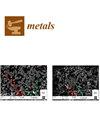Behaviour of Dissimilar Welded Connections of Mild Carbon (S235), Stainless (1.4404), and High-Strength (S690) Steels under Monotonic and Cyclic Loading
IF 2.5
3区 材料科学
Q3 MATERIALS SCIENCE, MULTIDISCIPLINARY
引用次数: 0
Abstract
In the context of an increasing interest in the use of high-performance steels in the construction industry due to their superior mechanical properties, understanding the behaviour and assessing the performance of dissimilar welded connections becomes essential. When several steel grades are adopted for fabrication of the same dissipative element, dissimilar welded connections have a decisive importance regarding the seismic performance of the structural member. This paper presents the experimental results of monotonic and low-cycle fatigue (LCF) tests on dissimilar welded connections. The welded connections are designed to reproduce the loading state that occurs between the web and the flanges of dissipative links in an eccentrically braced frame, and represent combinations of S235 mild carbon steel, 1.4404 austenitic stainless steel, and S690 high-strength steel. The obtained experimental results provide a better understanding of the behaviour of dissimilar welded connections through the evaluation of their strength, ductility, and failure mechanisms, providing a basis for finite element (FE) models’ calibration for further numerical simulations. This study contributes to the evaluation of the feasibility of connections between dissimilar steels in seismic-resistant steel structures.低碳钢 (S235)、不锈钢 (1.4404) 和高强度钢 (S690) 的异种焊接连接在单调和循环载荷下的行为
由于高性能钢材具有优异的机械性能,建筑行业对其使用的兴趣与日俱增,在此背景下,了解异种焊接连接的行为和评估其性能变得至关重要。当采用多种钢材制造同一消能构件时,异种焊接连接对于结构构件的抗震性能具有决定性的重要意义。本文介绍了异种焊接连接的单调和低循环疲劳(LCF)试验结果。焊接连接的设计再现了偏心支撑框架中耗散连接的腹板和翼缘板之间的加载状态,代表了 S235 低碳钢、1.4404 奥氏体不锈钢和 S690 高强度钢的组合。所获得的实验结果通过评估异种焊接连接的强度、延展性和失效机制,使人们更好地了解了其行为,为进一步的数值模拟提供了校准有限元(FE)模型的基础。这项研究有助于评估抗震钢结构中不同钢材之间连接的可行性。
本文章由计算机程序翻译,如有差异,请以英文原文为准。
求助全文
约1分钟内获得全文
求助全文
来源期刊

Metals
MATERIALS SCIENCE, MULTIDISCIPLINARY-METALLURGY & METALLURGICAL ENGINEERING
CiteScore
4.90
自引率
13.80%
发文量
1832
审稿时长
1.5 months
期刊介绍:
Metals (ISSN 2075-4701) is an open access journal of related scientific research and technology development. It publishes reviews, regular research papers (articles) and short communications. Our aim is to encourage scientists to publish their experimental and theoretical results in as much detail as possible. Therefore, there is no restriction on the length of the papers. The full experimental details must be provided so that the results can be reproduced. Metals provides a forum for publishing papers which advance the in-depth understanding of the relationship between the structure, the properties or the functions of all kinds of metals.
 求助内容:
求助内容: 应助结果提醒方式:
应助结果提醒方式:


